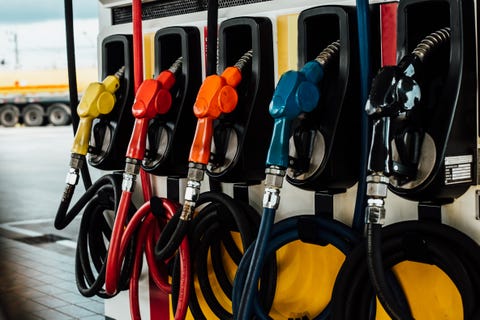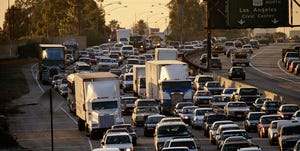
MR.WUTTISAK PROMCHOOGetty Images
- The federal government has announced its new rules to finalize fuel consumption and emissions standards; they’re in effect for the 2021–2026 model years.
- Fuel consumption and emissions must be reduced by 1.5 percent each year, whereas the original proposal froze the standards at 2020 levels.
- California and other states continue to wage a lengthy legal battle to overturn it.
Relaxed fuel-economy rules are now in effect. For new cars built over the next six years, automakers must still increase efficiency and lower carbon dioxide emissions each year but at a lower climb versus the original Obama-era regulations from 2012.
Under the new rule affecting new cars and light-duty trucks from the 2021 through 2026 model years, fuel consumption and emissions must each drop by 1.5 percent annually as compared to the 2012 ruling’s 5 percent annual decreases. The draft proposal from the Trump administration in 2018 had frozen the 2020 model-year standards and applied them through 2026. On a media conference call Tuesday, officials from the Environmental Protection Agency (EPA) and the National Highway Traffic Safety Administration (NHTSA) said that a significant number of the proposal’s 750,000 public comments pleaded for annual increases.
The previous rule required an industry fleet-wide average of 54.5 mpg by the 2025 model year, which was later amended to 46.7 mpg. The final rule is 40.4 mpg. However, obscure and dated calculations that NHTSA uses to set the Corporate Average Fuel Economy (CAFE) level means they’re higher than the window-sticker estimates on new cars. Either way, the new rule lowers them.
“They are still more realistic and achievable than 2012 standards,” said EPA administrator Andrew Wheeler.
In doing so, the new rule ups the estimates of emissions and fuel consumption. Compared to the previous rule that the EPA rushed to finalize during Obama’s last months in office—completely skipping a midterm review the EPA had scheduled for 2018—the new rule would increase the nation’s fuel consumption by up to two billion barrels and 923 milion metric tons of CO2.
“We hope that everyone will sit down and review this analysis,” said NHTSA acting administrator James Owen. However, the agency is “prepared to defend this rule” in court, he said.
A Check on Credits and Market Reality
But while critics (and some automakers) have slammed the White House for increasing emissions, those increases exist only on government paper. They’re in relation to future targets that haven’t been met—targets the EPA says most automakers are still not meeting “without resorting to the use of credits.” In reality, the new rule continues to mandate an annual decrease in emissions and fuel consumption, just on a significantly gentler curve.
“Their [credit] banks have been significantly depleted and we’re not seeing the same demonstration of compliance from actual reductions,” said Anne Idsal, the EPA’s air quality assistant administrator.
Those federal credits (not to be confused with zero-emission-vehicle credits, which are part of the state-level ZEV mandate led by California) allow automakers to compensate for the many non-complying vehicles in their fleets that would otherwise lead to penalties. For example, in addition to building alternative-fuel vehicles like EVs, automakers can petition for “off-cycle” credits (such as high-efficiency alternators) that aren’t bench-tested during a vehicle’s certification or have nothing directly to do with efficiency, such as for automated and connected vehicle technology. The new rule will continue EV credits through 2026 and will bring back credits for natural gas vehicles, which dropped off the list years ago.
CAFE requirements, which for decades have tied lower efficiency with larger vehicle sizes, have also incentivized automakers to sell more SUVs, crossovers, and trucks—all of which burn more fuel. That shift away from cars, along with lower gas prices and an unforeseen boom in U.S. oil production, are part of why NHTSA and the EPA have weakened the rules. That, and because the agencies are convinced that rising car prices due to “unrealistic regulatory burden” are one reason why the American fleet, on average, is 12 years old. By the logic that older cars are less safe and pollute more—the same logic behind the Obama-era “Cash for Clunkers”—the cost-benefit, according to the final rule, is 397,000 fewer injuries, 46,000 fewer hospitalizations, and 3300 fewer fatalities over the estimated lifetime of the vehicles. Whether any of these estimates mean anything is up for debate.
And the Lawsuits
The debates will also spill into the nation’s courts. The state of California (which the EPA is fighting to revoke its waiver to set separate emissions standards) had objected to the Trump administration’s proposal before it was ever published. California and 10 other states following its ZEV mandate—along with other Democratic-led states—will continue waging war against the EPA and NHTSA over the next several years unless a Democrat wins the White House and overturns this new rule. That uncertainty for automakers, which had both pleaded for looser regulations after Trump took office while preparing for a rush of battery-electric cars to meet the Obama-era targets, won’t end anytime soon.
Source: Motor - aranddriver.com





